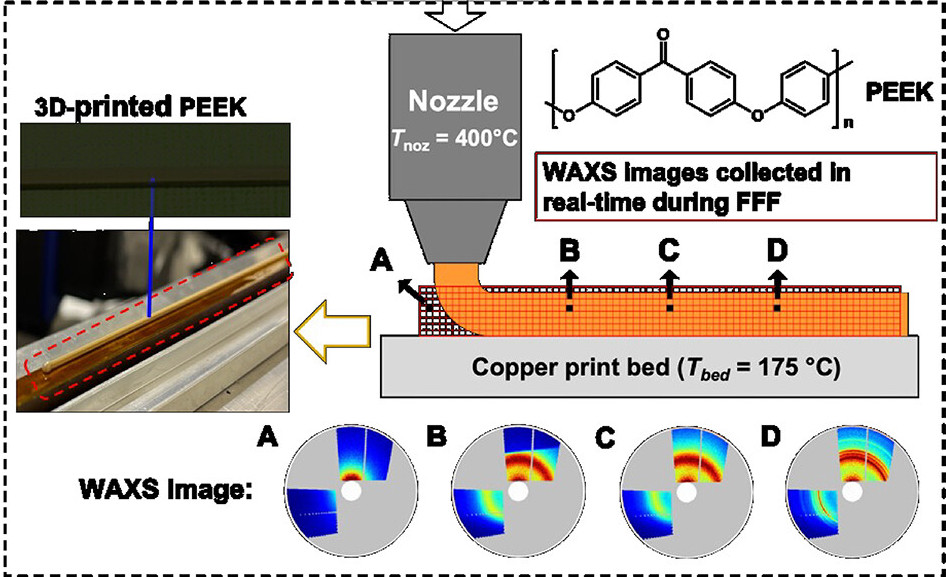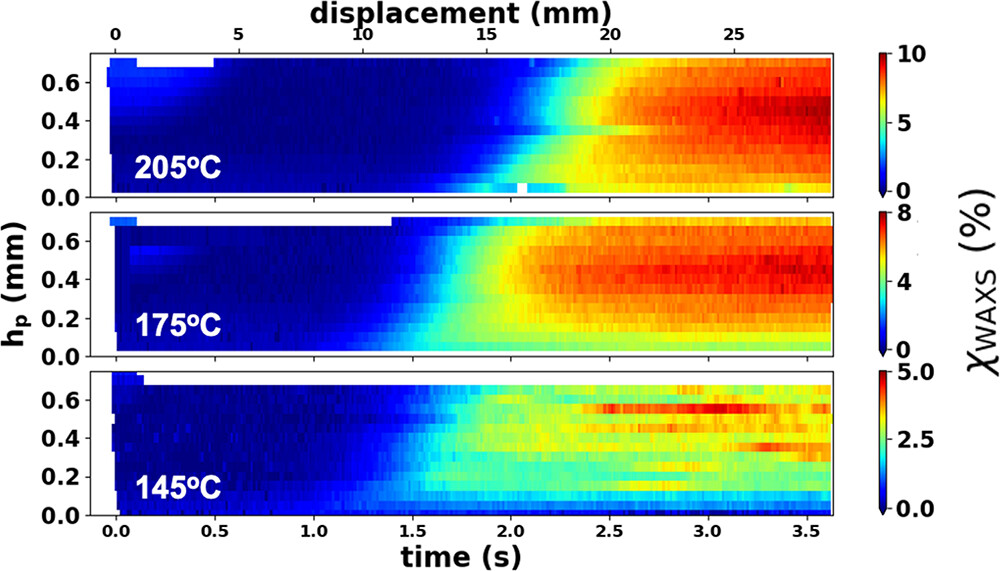Researchers from the Air Force Research Laboratory, Cornell University, and the Research & Technology arm of aerospace manufacturer Boeing have successfully mapped the crystallization process of poly(ether ether ketone) (PEEK) during 3D printing.
High-performance polymers, such as PEEK, are being increasingly used to produce 3D printed parts that require demanding mechanical properties, such as high-temperature resistance and reduced weight.
According to the researchers, a greater understanding of how the internal structures of these materials develop during 3D printing is essential to achieving greater control over the properties of 3D printed parts.
In the study, the team used a specialized X-ray imaging process to record how PEEK hardens into a layered crystal structure when 3D printed – a process also known as crystallization.
Achieving an “unprecedented level” of detail, the researchers have provided the first complete 2D map of the crystallization of a single layer during fused filament fabrication (FFF) 3D printing.
The findings, published in the journal Macromolecules, could provide designers and engineers with a greater understanding of how 3D printing parameters impact the mechanical properties of 3D printed parts. These parameters include material deposition rate, 3D print head speed, 3D print head temperature, 3D print bed temperature, and nozzle diameter.

Mapping 3D printed PEEK crystallization
The researchers argue that the understanding of the correlation between 3D printing parameters and the properties of final parts remains limited. This is said to be especially true for extrusion-based additive manufacturing of polymers such as PEEK, which possesses fast crystallization rates.
During the study, the team used synchrotron-based microbeam wide-angle X-ray scattering (WAXS) to record the crystal formation of the material during the FFF 3D printing process.
When X-rays are directed at materials, they come into contact with electrons and scatter in different directions. In WAXS, the angles and intensity at which this scattering occurs are plotted and analyzed to determine key information about the internal crystalline structure of the material.
Using this technique, the researchers successfully produced a detailed map of how PEEK crystallizes in the first few seconds following extrusion from the 3D printer’s nozzle. During experimentation, multiple 3D print runs were conducted and measured with varying print bed temperatures of 145℃, 175℃, and 205℃. The 3D printing nozzle was kept at a consistent temperature of 400℃.

The data collected during this testing was collated into a detailed 2D map showing how and where the material crystallized over time.
The findings indicate that crystallization of PEEK occurs first on the layers that are closest to the 3D print bed. This process then gradually moves vertically up the extruded material, until it has completely hardened.
The data also highlighted a clear correlation between increasing 3D print bed temperatures and the onset of crystallization. In effect, when 3D printing at higher 3D print bed temperatures, it takes longer for the material’s hardening process to begin.
What’s more, the researchers found that materials 3D printed at higher print bed temperatures possessed a higher final degree of crystallization, translating to increased hardness and density.
Ultimately, the researchers claim that these findings could allow those leveraging PEEK to better control 3D printing parameters to accurately determine the mechanical performance of the 3D printed parts.

Controlling material properties in 3D printing
This is not the first time researchers have sought to achieve greater control over part properties in 3D printing
Back in 2020, a team from the University of Nantes published a study investigating the heat transfer and adhesion between layers in FFF 3D printing.
Through this project, the researchers sought to understand, model and quantify the heat exchanges in the 3D printing process. It was hoped that this would help to determine the optimal 3D printing parameters needed to maximize the mechanical properties of 3D printed parts.
Throughout their study, the Nantes researchers used a Creality CR-10 3D printer with ABS and carbon fiber-reinforced PEKK. Precise temperature measurements of heat transfer throughout the 3D printing process were taken using an infrared camera, and compared to a predictive numerical model.
Ultimately it was found that the numerical model correctly predicted heat transfer in 3D printing. However, “poor knowledge of the rheological properties” prevented the team from accurately predicting layer adhesion, a key factor in determining final part properties.
Away from FFF, University of Colorado Boulder researchers have developed a novel process for determining material properties in inkjet 3D printing. Called a “pantone for properties,” the study highlights how different resin materials can be combined in multi-material inkjet 3D printing to determine specific material properties. These different materials include a soft elastomer, a rigid plastic, and liquid constituents.
According to the researchers, these findings offer potential for 3D printing mechanically-plausible synthetic biological tissue used in medical applications.
What does the future of 3D printing hold?
What near-term 3D printing trends have been highlighted by industry experts?
Subscribe to the 3D Printing Industry newsletter to keep up to date with the latest 3D printing news. You can also follow us on Twitter, like our Facebook page, and subscribe to the 3D Printing Industry Youtube channel to access more exclusive content.
Are you interested in working in the additive manufacturing industry? Visit 3D Printing Jobs to view a selection of available roles and kickstart your career.
Featured image shows the researcher’s 3D printing experimental setup. Photo via Macromolecules.


